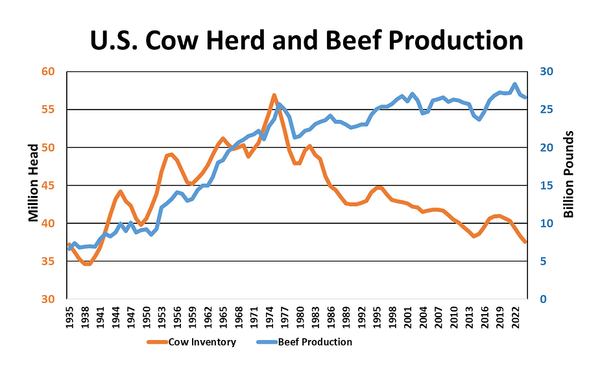By Tim Petry, Livestock Marketing Economist, Angus Journal
The United States is the leading producer of beef in the world and has been for many years. Following the United States, in order, are Brazil, China, Argentina and Australia.
The USDA Foreign Agricultural Service publishes a quarterly report titled “Livestock and Poultry: World Markets and Trade.” The report includes data on U.S. and global livestock and meat production, trade, consumption and stocks, with analysis of developments affecting world livestock, including cattle, beef and poultry.
It is available at: https://fas.usda.gov/data/livestock-and-poultry-world-markets-and-trade.
The most recent report was released April 11, and the next report will be released July 12.
Global beef production in 2024 is forecast to be unchanged from 2023 at 60.4 million tons, as declining production in the United States and Argentina will be offset by increases in Australia, Brazil and China.
U.S. beef production has been on a long-term uptrend in spite of a decline in cow numbers since 1975. Cow numbers include both beef and dairy cows.
U.S. dairy cow numbers peaked in 1945 at 27.8 million head and have generally declined since then. Dairy and beef cow numbers were essentially equal in 1953 at 23 million head each.
U.S. beef cow numbers continued increasing until 1975 when they reached 45.7 million head. Since then beef cow numbers have generally declined with cyclical declines outpacing cyclical increases.
Jan. 1, 2024, U.S. beef cow numbers were 28.2 million head. With 9.4 million dairy cows, total cow numbers were 37.6 million head.
Beef cow numbers declined for five years from 2019 through 2023, mainly due to drought conditions in important U.S. cattle producing regions.
U.S. beef production reached an all-time record high of 28.29 billion pounds (lb.) in 2022, buoyed by drought-forced beef cow liquidation. In 2023 beef production declined to 26.96 billion lb., with fewer cattle available.
The long-term increase in beef production resulted from a long-term increase in fed cattle live and carcass weights. Carcass weights have trended higher for more 60 years with steer weights increasing an average of 4 lb. per year. Steer carcass weights peaked in 2022 at 910 lb., but declined slightly to 908 lb. in 2023.


